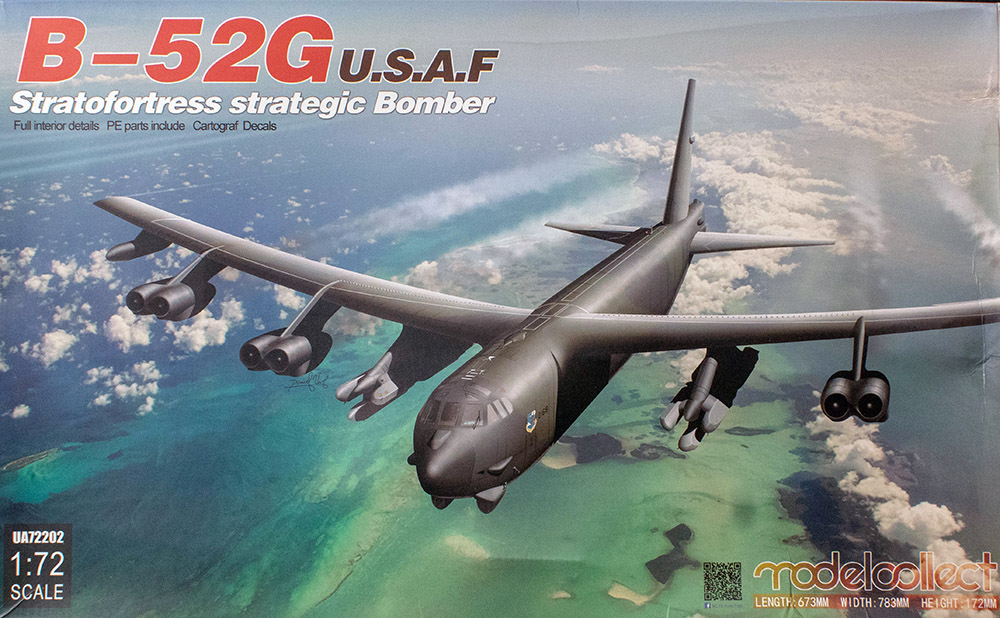
Modelcollect 1/72 B-52G Stratofortress Kit First Look
By Michael Benolkin
| Date of Review | August 2018 | Manufacturer | Modelcollect |
|---|---|---|---|
| Subject | B-52G Stratofortress | Scale | 1/72 |
| Kit Number | 72202 | Primary Media | Styrene |
| Pros | Nice details | Cons | See text |
| Skill Level | Experienced | MSRP (USD) | $119.99 |
First Look
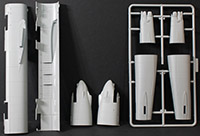 |
 |
 |
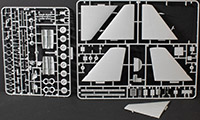 |
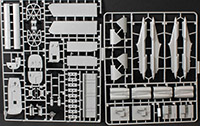 |
 |
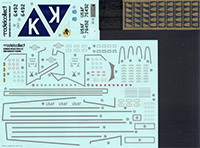 |
The B-52 Stratofortress is an eight-engined long-range strategic bomber that was designed to replace the B-36 Peacemaker. Where the B-36 was powered by six huge piston engines (and later with an additional four jet engines), the B-52 was a pure jet aircraft. Where the B-36 was not air refuelable, the B-52 can air refuel. Where the B-36 was designed as a long-range conventional bomber that was adapted to the nuclear deterrence mission, the B-52 was designed for the nuclear deterrence mission and was adapted to also support the conventional bombing mission. Nicknamed the BUFF (for Big Ugly Fat 'Fellow'), the B-52 was first flown in 1952, with the last B-52 coming off the production line by 1962. The XB-70 that was to become the high-speed replacement for the B-52 was cancelled. The Mach 2 B-1A Lancer was also cancelled. The Mach 1+ B-1B Lancer did eventually enter production, but not in sufficient quantities to replace the B-52. The stealth B-2 Spiirit also entered production, but again in small quantities, leaving the B-52 to soldier on.
The B-52G was supposed to be an interim variant due to production delays with the B-58 Hustler. The G-model incorporated a number of design changes over the previous B-52 models including: larger radome, shorter vertical stabilizer, wet wings with greater fuel capacity, smaller external tanks, relocated tail gunner (tail gun remote controlled from forward crew compartment station), elimination of ailerons, etc. The G-model was primarily roled as a nuclear bomber while the previous B-52s conducted conventional bombing missions over Vietnam. Many of the G-models were updated to carry nuclear cruise missiles and under the SALT II treaty, special leading edge fairings were added to the wing roots to identify the aircraft as being covered under that treaty.
While Monogram released the 1/72 B-52D years ago, the only production kit of the B-52G in this scale came from AMT/ERTL which was released in 1994. This kit has been released in the SALT II and the pre/post SALT II (no wingroot fairings) configurations. Like most of the AMT/ERTL kits, their B-52 kits were molded from a softer styrene, which had some interesting (not good) reactions to some glues as well as sagging over time.
Here is Modelcollect's second 1/72 bomber kit and the first of the B-52 series - the B-52G. I preordered this kit from the manufacturer some time ago and was pleasantly surprised to receive a shipping notice a few weeks ago. While the shipping box looked worse for wear (the box was slightly crushed and still damp from exposure to the elements), the kit survived and neither the decals nor instruction book were exposed to the dampness. In addition, none of the kit's parts were damaged.
The kit is molded in gray styrene and presented on 31 parts trees (duplicate trees not shown), plus one tree of clear parts and two frets of photo-etched parts. Among the features and options:
- Nicely detailed flight deck with photo-etched instrument panels and consoles for the pilot/copilot
- Crew stations at rear of flight deck and crew compartment under flight deck provided with minimal details (you can't see them through the windscreen)
- Positionable crew entry door
- Positionable bomb bay doors
- Rotary launcher provided for bomb bay
- Wheel wells are detailed
- Positionable outrigger landing gear
- Main landing gear provided as extended only (you can modify the model for gear-up, but at present, I don't know how well the landing gear doors fit
- Choice of ALCM or Tomahawk underwing pylons
- Choice of AGM-86 ALCM or AGM-109 Tomahawk payloads
The kit provides a nice set of airframe stencils and markings for one subject:
- B-52G, 57-6492, 524 BS/379 BW, Wurtsmith AFB, 'Old Crow Express'
With the exception of the crew stations at the rear of the flight deck and the inclusion of the lower deck, this kit is not over-engineered with details where you won't see them after assembly. The design seems straightforward though I marked the skill level as experienced due to the size of the model and use of photo-etch.
Notes:
- The kit represents a B-52G with the Electro-Optical Viewing System (EVS) under the nose, not fitted with the SALT II wingroot fairings, and retains the tail gun. That put's this model roughly between 1972-1992.
- The kit subject is a conventional bomber circa Operation Desert Storm (1991).
- The surface of the kit parts have a slight texture with scribed detailing, not a problem for a camouflaged subject. B-52Gs in this configuration did not appear in bare metal.
- The kit does not replicate the 'wrinkles' in the fuselage fore and aft of the wing. You'll have to add those yourself.
- While the wing-fuselage joint uses a slot and tab for mechanical alignment, I will probably supplement that with a spar that will extend through the fuselage into both wings for extra strength for handling of the model.
- The kit does not have the conventional I-beam external pylons/suspension system for bombs.
- The kit has separately molded flaps, but no provision for displaying them extended. You'll need to fabricate your own Fowler flap tracks to position them extended.
- As shown in the photos, the wing has a slight sag molded to obtain the right 'sit' on its outrigger landing gear.
- It is interesting that Modelcollect designed the aft flight deck crew stations as well as the crew stations below the flight deck even though there is no way to see them after assembly.
- The color call-outs are provided using Ammo by Mig paints only. The painting and decal placement instructions only provide the left side profile, so you're on your own for the right side. You'll need to find the FS colors for this subject and whether this aircraft used a two or three-colored camouflage scheme. If I use the kit decals, I'll need to dig into my own references.
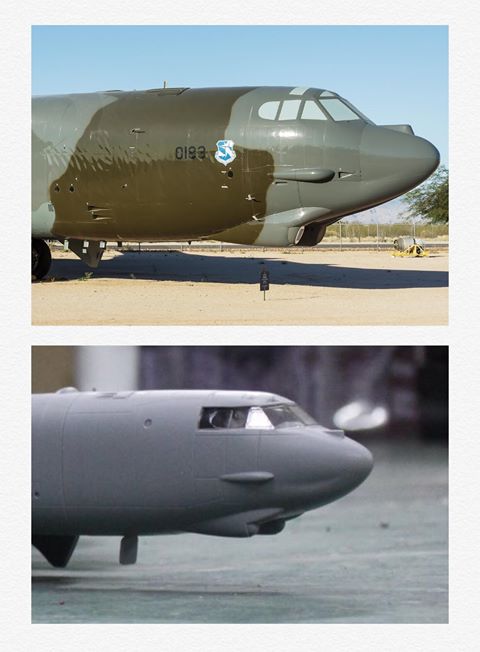
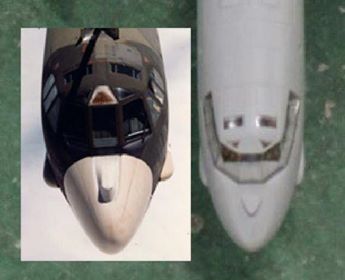
While my initial impressions of the kit were favorable, it didn't take long after posting this first-look that a number of readers were pushing back on the accuracy of the kit. The first image is a look at the nose section of B-52G 58-0183 at the Pima Air and Space Museum compared to the forward fuselage of this kit while the second image shows a B-52G air refueling versus the same perspective on the kit. You can see the shape of the radome isn't long/pointed enough, the EVS fairings are incorrect (as are the sensor 'bumps'), the NACA scoops on the actual aircraft are not present on the kit, the overhead hatches for the rear flight deck seats are too far aft, and more. And this just looks at the nose section. You can also see how different the kit nose section looks without the 'wrinkles' that are visible on the full-scale aircraft.
Another interesting glitch you can't see in these images is the rear tail section/tailgun. The B-52G was the first to move the tail gunner to the forward cockpit and while the gun gimbal remained in its original position/station, the radars were moved forward to fill the void left by the gunner's compartment. In this kit, it looks like Modelcollect took the B-52D tailgun and simply faired over the gunner's compartment and didn't add the antenna bumps fitted to the G-model.
Are these things fixable? Perhaps, but for a new-tooled kit, why do we need to? I had hoped that the Buff Master resin conversions would help with making this kit right, but unfortunately they are rather crude castings that create a whole new group of problems not worth solving. Save yourself some time and money and avoid this kit and any thought of using Buff Master's products to make it right.







